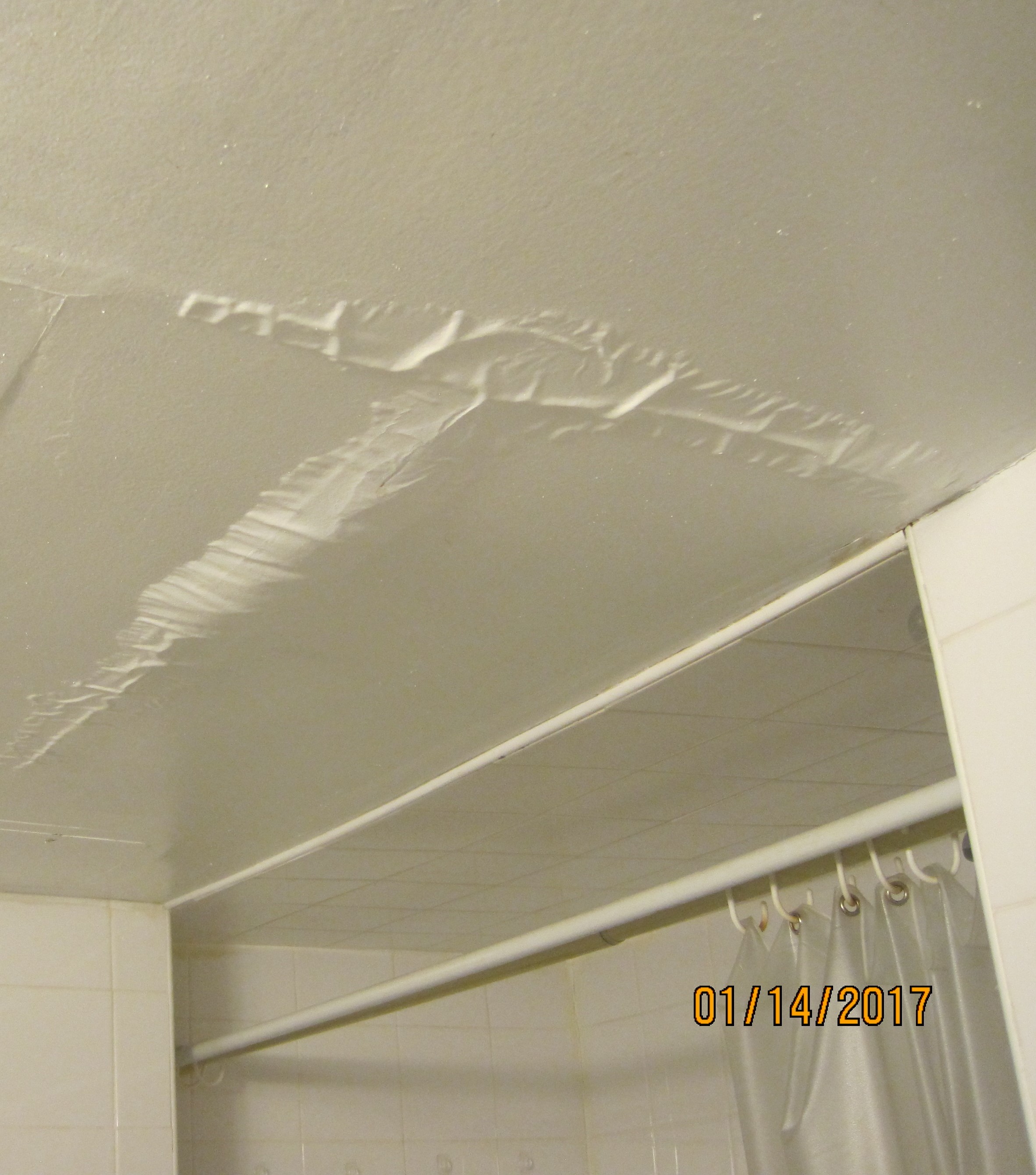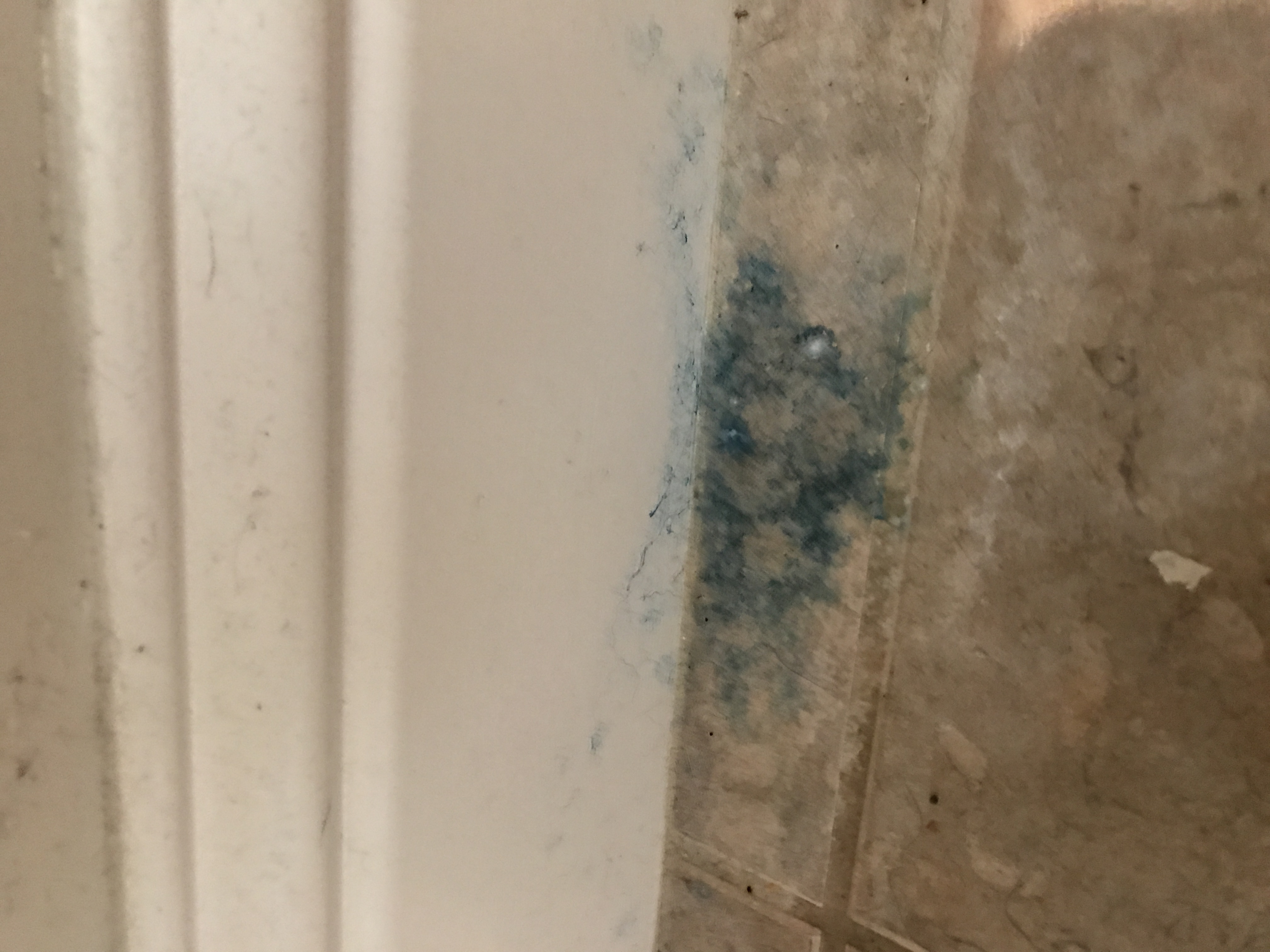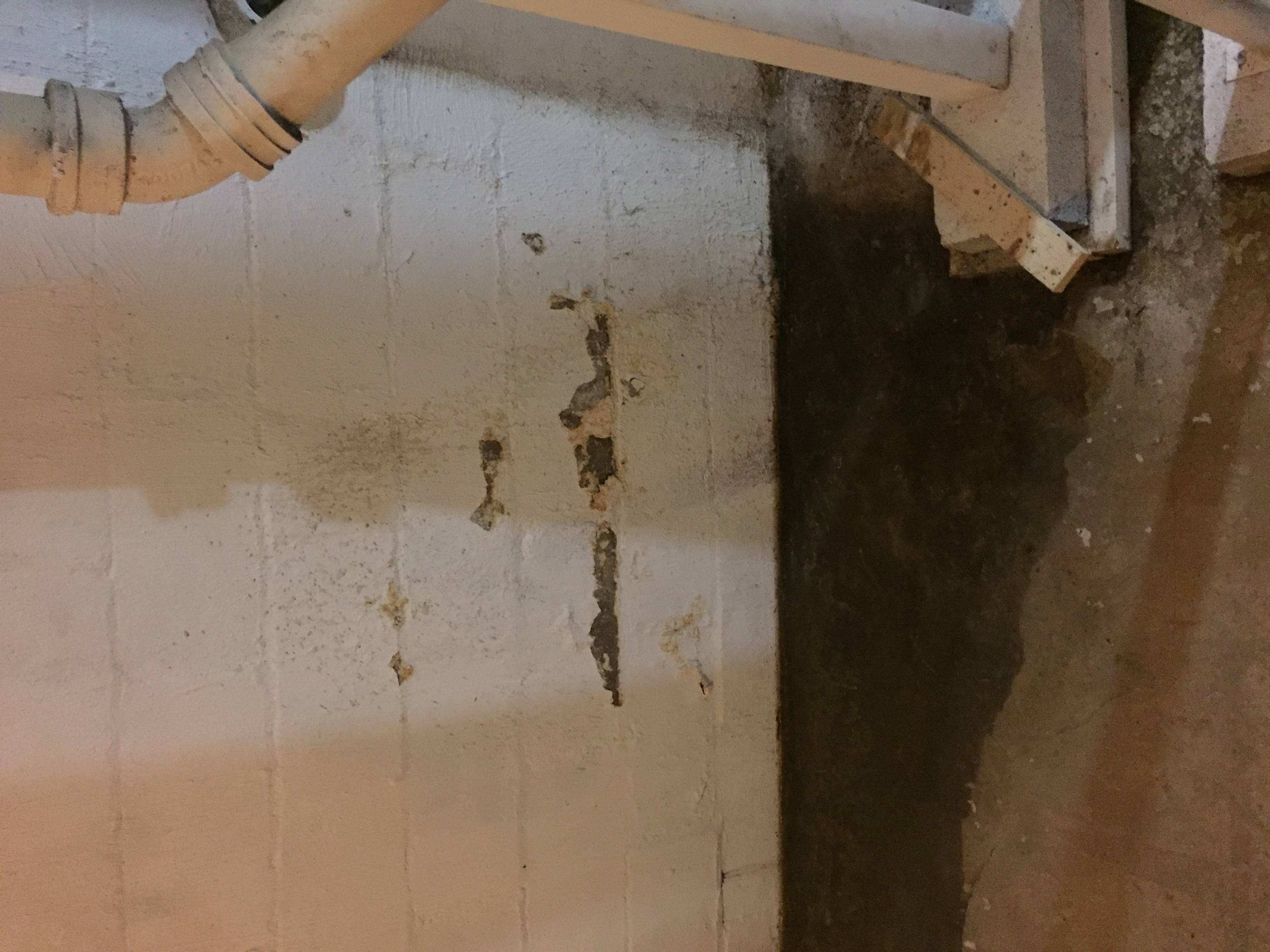I researched how to get rid of mold. I found out that it is impossible to get rid of all the mold because mold spores will be floating around in the indoor air and in the dust particles as well. As long as you don’t have any moisture problems in the home, you shouldnt have mold problems. Mold needs moisture to grow. If you have a moisture problem and do nothing about it then mold will continue to grow or re-occur.
This is an image from a recent inspection, it is a ceiling in a lower level bathroom. Apparently, the upper bathroom drain had been leaking for some time and was dripping on the ceiling below. The upper bathroom had no visual evidence of the leak or mold growth, however, there was a strong musty odor. The lower bathroom had strong evidence of the leak and mold growth, along with a musty odor.
Water intrusion is obviously key to the start of mold growth. I actually own a second home with a basement that has water intrusion all throughout a rain of any volume or severity. Ironically this was a home purchased with severe mold. So severe that I had to sign a waiver just to enter the home for inspection. My father and I renovated the home, successfully remediated the mold issue that was mostly due to the prior occupants transforming the leaking basement into living space, but we do have to still deal with the leaking basement.
Thanks
Great course!
Essay
The photo of the floor joist located at the crawl space entrance indicates that there is apparent mold growth present. The apparent mold growth was confined to this area of the crawl space. Recommend having a surface sample taken to determine if there is mold growth present.

Mold, Moisture and Your Home
The article is written with the consumer in mind. It gives good general information regarding why mold may be growing in your home, the health concerns related to mold growing in your home, how do get rid of it, and who should do the cleanup. It also offers tips and techniques for mold cleanup by a consumer

This a photo of the underside of the roof sheathing in an attic. Their are visual indication of mold growth. Instead of reporting that their was a mildew/mold like substance, I recommend to my client that I take a tap/surface sample and have it tested my a lab for mold growth. In this case the lab results come back positive for mold growth. I recommend that they having a mold professionals evaluate to discuss options and costs for any necessary repairs.
In the northern U.S., moisture vapor problems are driven primarily by high indoor relative humidity levels, combined with low outdoor temperatures during the winter. In the southern U.S. (especially the southeast), the problem is largely driven by high outdoor humidity and low indoor temperatures during summer months. Mixed climates are exposed to both conditions and can experience both types of problems. Humid climates, in general, will be more of a problem than dry climates. Wind-driven rain is the main cause of leaks through the building envelope.
Inspecting homes in Florida its not hard to find mold or microbial growth.
Even on materials such as metal you can find mold growing. I have learned that all it takes is the presence of moisture such as condensation on metal window frames or HVAC systems located in humid environments such as a garage and you can have mold growing. Its the dust accumulation that provides the food source for the mold. So any area that has a constant source of moisture can develop microbial growth. 
I read the article on moisture intrusion. The main controlling factor in maintaining a mold free environment inside your home is to eliminate moisture intrusion. In Florida water vapor is a common way moisture can develop where you don’t want it. The humid air can condense on a cold surface such as A/C ducts, air handlers and uninsulated condensate lines and create a persistent source of moisture. Another source is from wind driven rain which causes water to run down the surface of exterior walls and windows. Any horizontal seam not well sealed can present an entry point into the wall.
I recently completed a home inspection on this property. There was a deteriorated flat roof that I recommended be replaced in my inspection report. The contractor that replaced the roof left it open and it rained that night. I was asked to return to the property to complete a 4 Point Insurance Inspection. I inspected the area of rain damaged drywall that had been removed. The was no musty smell and my infra red scan indicted there was no active moisture in the walls or ceiling.

This is a photo of a basement bathroom ceiling. The bathroom is located under a first floor bathroom. The first floor bathroom shower tile was in terrible condition; grout was cracked and missing, tiles were cracked and tiles had been replaced with slightly smaller tiles. The ceiling in the basement pictured was coated with some kind of roller applied rubber coating that trapped all the water leaking from above. When pushed, I could feel that these blisters were filled with water. The light fixture / ventilation fan showed signs of rust. The tenant had indicated that this condition had been going and that the rubber coating was the only thing that covered the dark spots and stains.
I read “Basic Waterproofing for Basements”. For obvious reasons waterproofing existing basements can be problematic. Positive side waterproofing means digging large trenches along the outside of the foundation and can be expensive as well as damaging to existing landscaping. Negative side waterproofing solutions as discussed in the article have issues as well. Sealing the inside face of the foundation seems like a temporary solution to me. Moisture absorbed in the outer half of the foundation wall can will cause issues over time. The hydro-static pressure can build up until it causes other cracks or spalling of the concrete wall. These interior coatings also trap moisture in the basement so dehumidifiers are needed.
In one of my last inspections I found what I thought was a possible leaking toilet wax ring. While what I really wanted to say was pull the toilet and change the wax ring I didn’t. I try not to blow it out of proportion so I reported as: Dirt and grime noted at the base of a bathroom toilet. While this may just be poor housekeeping it’s possible the toilet’s wax ring is leaking. We recommended further review and repair as needed. I see this type of problem with toilets often and this is my saved statement I use.
I choose the pool and spa plumbing layout. I inspect pools and spa regularly, but I don’t feel 100% about every aspect of the pool and spa function. I’ve taken pool classes at our local CREI convention, but I still run across thing I don’t know. One question I’ve been asked by multiple clients is can you drain a pool with the pool pump or do you have to have a separate pump you drop into the pool. By examining the pool and spa plumbing drawing I feel comfortable in saying you can drain the pool with pool pump. Thank you!
Upon arrival for the limited inspection, client indicated an area of possible mold concern. The client advised there was an area in the hall bathroom where a green substance was located behind the toilet. No water damage was noted upon inspection. The substance was not consistent with a mold or fungi. No smells consistent with mold were noted at the time of the inspection. Upon inspection, inspector found there appeared to be a leak coming from the toilet. The green substance was also noticed coming from the area of the tank bolts, and appears to be dripping off the toilet and landing onto the wall behind the toilet. At the discretion of the inspector, no samples were taken as there were no areas of concern noted. Client was advised of the need to have the toilet inspected for repairs to fix the issue and prevent potential future water damage or mold growth.
For this research exercise I chose a consumer related article titled “Mold, Moisture and Your Home”. The article was very informative and should be a great read for the average client who has questions or concerns about mold or it’s cleanup and removal. I found the article to be complete and simple to understand for the average consumer. This would be a good handout for clients with questions when completing an inspection as it offers sufficient details about mold, it’s causes, cleanup, removal, safety, as well as how to prevent future concerns. It was a good choice for the research project.
There is a hole in the foundation wall along the rear wall of the basement. There is active water intrusion from this hole that is allowing water onto the foundation wall and floor. This moisture intrusion is conducive to mold growth and should be corrected.
Mold article
Molds are part of the natural environment. Outdoors, molds play a part in nature by breaking down dead organic matter, such as fallen leaves and dead trees. But indoors, mold growth should be avoided. Molds reproduce by means of tiny spores; the spores are invisible to the naked eye and float through outdoor and indoor air. Mold may begin growing indoors when mold spores land on surfaces that are wet. There are many types of mold, and none of them will grow without water or moisture.
logging into mold course
Fungi grow well in moist, dark areas, but can be found wherever organic material is available. Molds can grow on a variety of surfaces, including paint, jet fuel, wallpaper, glass, drywall and stainless steel. Moisture is necessary for mold growth. Moisture may come from the air and from the material upon whichmold grows. If the environment becomes very dry, fungi can survive by going dormant or by producing spores that resist drying out.The caption pictured above is mold growth on drywall. A qualified professional should be contacted when dealing with areas more than 10 sq. feet.





